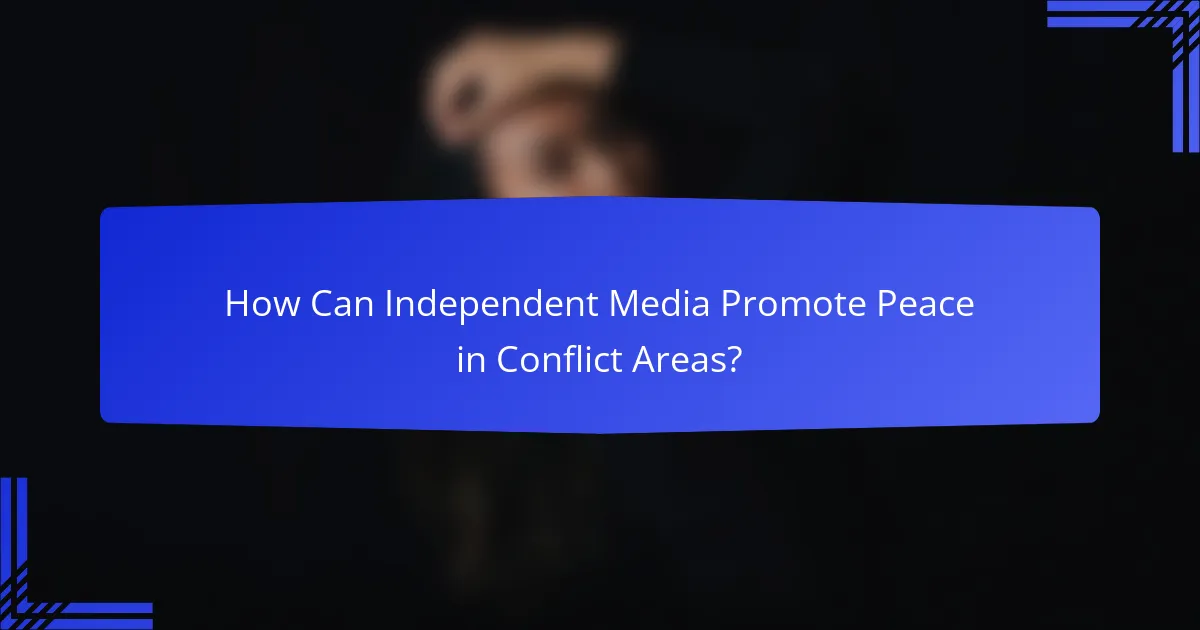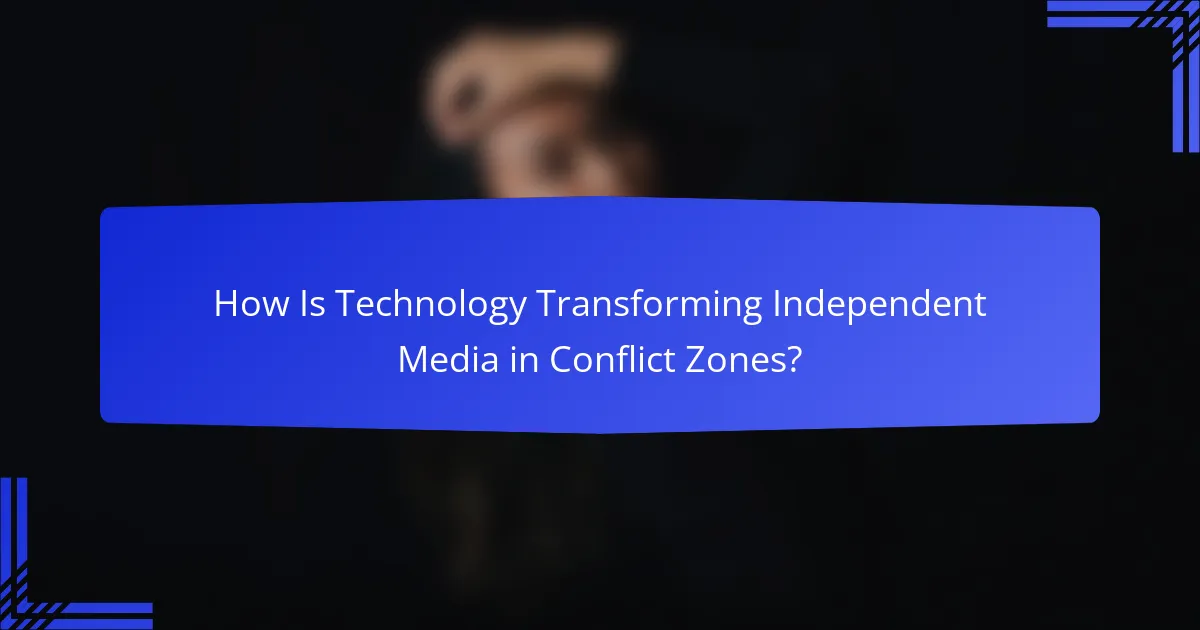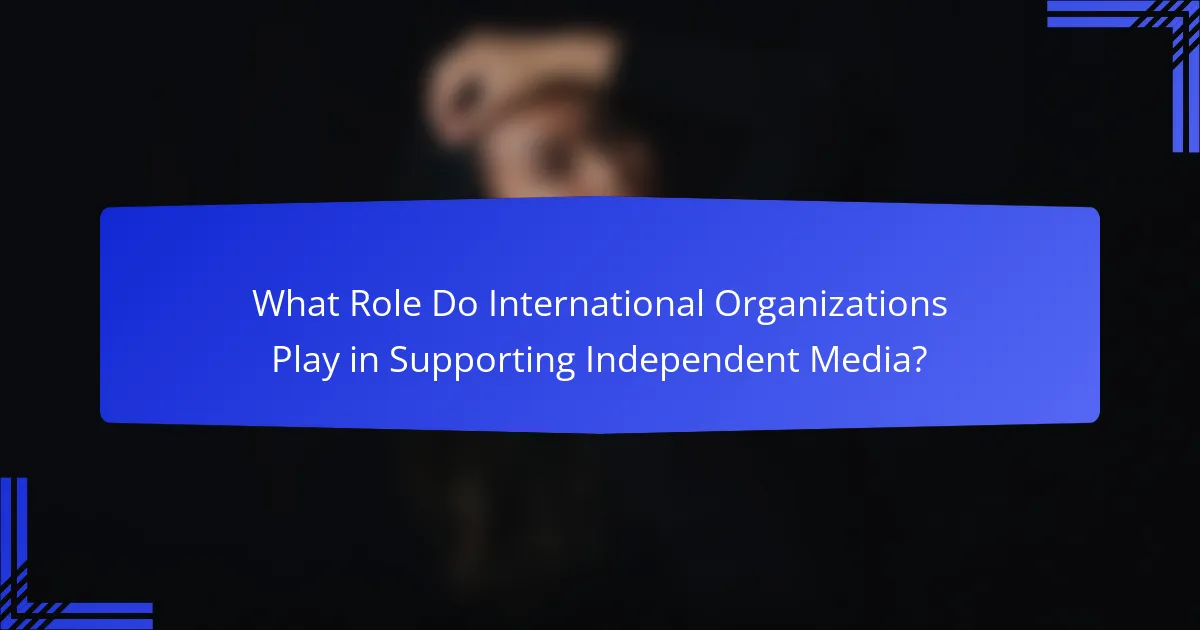Independent media plays a crucial role in conflict zones by delivering unbiased information and amplifying local narratives, often at great personal risk. By providing diverse viewpoints and critical analysis, these outlets counter state-controlled narratives and help shape public perception, fostering informed opinions among audiences. Additionally, independent media promotes peace by encouraging dialogue and raising awareness of humanitarian issues, ultimately bridging divides and fostering understanding in tumultuous environments. This is particularly evident in the media coverage of international conflicts during wars.

How Does Independent Media Operate in Conflict Zones?
Independent media in conflict zones operates by providing unbiased information and analysis, often under challenging conditions. These media outlets focus on local narratives, ensuring that the voices of affected communities are heard despite the risks involved.
Local reporting initiatives
Local reporting initiatives are crucial for capturing the realities of conflict zones. These initiatives often involve journalists from the affected areas who understand the cultural and social dynamics, allowing for more accurate and relevant reporting. They may operate through small, community-based organizations that prioritize safety and ethical journalism.
Examples include grassroots news networks that rely on citizen journalists to report on events as they unfold, often using mobile technology to share information quickly. This approach not only empowers local voices but also helps to counter misinformation that can proliferate during conflicts.
Digital platforms for information dissemination
Digital platforms play a vital role in disseminating information in conflict zones, enabling rapid communication and outreach. Social media, blogs, and independent news websites allow journalists to share updates and stories with a global audience, often bypassing state-controlled media. This immediacy can be critical for raising awareness and mobilizing support.
However, the reliance on digital platforms also presents challenges, such as the risk of censorship and the spread of false information. Independent media must navigate these hurdles by verifying sources and maintaining transparency about their reporting processes.
Collaboration with NGOs
Collaboration with non-governmental organizations (NGOs) enhances the effectiveness of independent media in conflict zones. NGOs often provide resources, training, and safety protocols for journalists, helping them to operate more securely and effectively. This partnership can also facilitate access to critical information and support for affected communities.
For instance, some NGOs focus on media literacy programs that educate the public on distinguishing credible news sources from misinformation. Such initiatives not only strengthen independent media but also empower citizens to engage critically with the information they consume.

What Impact Does Independent Media Have on Public Perception?
Independent media significantly shapes public perception by providing diverse viewpoints and critical information during conflicts. It helps audiences understand complex situations, often countering state-controlled narratives and fostering informed opinions.
Shaping narratives
Independent media plays a crucial role in shaping narratives by highlighting underreported stories and perspectives. By focusing on local voices and experiences, these outlets can challenge dominant narratives that may be skewed or biased, thus enriching public discourse.
For example, during conflicts, independent journalists often report on humanitarian issues and civilian experiences, which can shift public sentiment and encourage empathy. This narrative-building can lead to greater awareness and advocacy for affected populations.
Influencing international response
Independent media can significantly influence international responses to conflicts by bringing attention to crises that may otherwise be ignored. By disseminating information about human rights abuses or humanitarian needs, these outlets can mobilize international organizations and governments to take action.
For instance, coverage of a conflict’s impact on civilians can lead to increased foreign aid or diplomatic pressure. The visibility created by independent media often prompts quicker responses from international bodies, which can be critical in mitigating suffering and promoting peace efforts.

How Can Independent Media Promote Peace in Conflict Areas?
Independent media can promote peace in conflict areas by providing unbiased information, fostering dialogue, and raising awareness of humanitarian issues. By reporting on local perspectives and events, these media outlets help bridge divides and encourage understanding among conflicting parties.
Facilitating dialogue
Independent media plays a crucial role in facilitating dialogue by creating platforms for discussion among various stakeholders. Through interviews, talk shows, and community forums, they encourage voices from different sides to share their views, which can lead to mutual understanding and conflict resolution.
For example, a local radio station in a conflict zone might host a series of debates featuring representatives from opposing groups. This not only humanizes the “other side” but also allows for the exploration of common ground, which is essential for peacebuilding.
Highlighting humanitarian issues
By highlighting humanitarian issues, independent media can draw attention to the needs and suffering of affected populations, prompting local and international responses. Coverage of topics such as displacement, access to healthcare, and food security can mobilize aid and resources to those in need.
For instance, reporting on the plight of refugees or internally displaced persons can lead to increased donations and support from NGOs and governments. Additionally, showcasing stories of resilience and recovery can inspire hope and solidarity within communities, further contributing to peace efforts.

What Challenges Do Independent Media Face in Conflict Zones?
Independent media in conflict zones encounter significant challenges that hinder their ability to report effectively. These challenges include threats to journalists, difficulties in accessing reliable information, and issues related to funding and sustainability.
Threats to journalists
Journalists operating in conflict zones often face severe threats, including violence, intimidation, and even abduction. These risks can stem from various sources, such as government forces, militant groups, or criminal organizations, all of which may seek to suppress dissenting voices.
To mitigate these threats, journalists should prioritize their safety by adopting security protocols, such as using secure communication methods and establishing emergency plans. Training in conflict reporting can also enhance their ability to navigate dangerous situations.
Access to reliable information
In conflict zones, obtaining reliable information is a major challenge due to censorship, propaganda, and the chaotic nature of war. Independent media often struggle to verify facts amidst conflicting narratives and misinformation spread by various factions.
To improve access to accurate information, journalists can build networks with local sources, utilize technology for real-time updates, and cross-check data with multiple outlets. Engaging with international organizations can also provide valuable insights and resources.
Funding and sustainability issues
Independent media in conflict areas frequently face funding challenges, as traditional revenue streams may dry up due to instability. This can lead to a reliance on foreign aid or grants, which may not be sustainable long-term.
To enhance sustainability, media organizations should explore diverse funding models, such as crowdfunding, partnerships with NGOs, or subscription-based services. Establishing a strong community presence can also foster local support and engagement, which is crucial for long-term viability.

How Is Technology Transforming Independent Media in Conflict Zones?
Technology is significantly reshaping independent media in conflict zones by enabling faster information dissemination and enhancing reporting capabilities. Tools such as social media and mobile journalism equipment empower journalists to share real-time updates and engage with global audiences, often in challenging environments.
Use of social media
Social media platforms like Twitter, Facebook, and Instagram have become vital for independent media in conflict zones. These platforms allow journalists to broadcast news instantly, often bypassing traditional media gatekeepers. For example, a journalist in a conflict area can tweet updates or share live videos, reaching thousands of followers within minutes.
However, the use of social media also comes with risks. Misinformation can spread rapidly, and journalists may face threats from hostile actors. It’s crucial for independent media to verify information before sharing and to use secure communication methods to protect their sources.
Mobile journalism tools
Mobile journalism tools, including smartphones and portable editing software, have revolutionized how news is reported in conflict zones. Journalists can capture high-quality photos and videos, edit content on the go, and publish stories directly from the field. This immediacy is essential in fast-moving situations where traditional reporting methods may be too slow.
When using mobile tools, journalists should ensure they have reliable internet access and backup power sources, as connectivity can be unstable in conflict areas. Additionally, they should be aware of local regulations regarding media and technology use to avoid legal issues.

What Role Do International Organizations Play in Supporting Independent Media?
International organizations play a crucial role in supporting independent media by providing financial resources, training, and advocacy. Their efforts help ensure that media outlets can operate freely and effectively, especially in conflict zones where press freedom is often under threat.
Funding initiatives
Funding initiatives are essential for the survival of independent media in conflict areas. International organizations often allocate grants and financial support to help these outlets maintain operations, purchase equipment, and cover operational costs. For instance, organizations like UNESCO and the International Media Support (IMS) provide targeted funding that can range from thousands to millions of dollars, depending on the project’s scope.
These financial resources can be critical in enabling media outlets to produce unbiased reporting and counter misinformation. However, it is vital for these organizations to ensure that funding is distributed transparently and equitably to avoid favoritism and promote diverse voices.
Training programs for journalists
Training programs for journalists are another key aspect of support from international organizations. These programs focus on enhancing journalistic skills, ethical reporting, and safety practices, which are particularly important in conflict zones. Workshops and online courses can cover topics such as investigative journalism, digital security, and crisis reporting.
Organizations like the Committee to Protect Journalists (CPJ) and Reporters Without Borders (RSF) often conduct these training sessions, equipping journalists with the necessary tools to navigate challenges in their environments. By investing in journalist education, international organizations help foster a more informed public and strengthen the overall media landscape.

How Does Independent Media Compare to State-Controlled Media?
Independent media operates independently from government influence, providing a platform for diverse viewpoints, while state-controlled media typically serves the interests of the ruling authority. This distinction is crucial in conflict zones, where the flow of accurate information can significantly impact public perception and safety.
Objectivity and bias
Independent media strives for objectivity by presenting multiple perspectives and fact-checking information before dissemination. In contrast, state-controlled media often exhibits bias, promoting narratives that align with government agendas. This can lead to misinformation, especially in conflict zones where the stakes are high and accurate reporting is essential for public awareness.
In practice, independent media outlets may face challenges such as limited resources and threats to their journalists, which can affect their ability to report impartially. For instance, while independent news sources may cover civilian casualties in a conflict, state media might downplay or ignore such reports to maintain a favorable image of the government. Audiences should critically evaluate sources, considering their funding, ownership, and the potential for bias.
To navigate these complexities, consumers of news should seek information from a variety of independent outlets and cross-reference reports. This approach helps to mitigate the effects of bias and provides a more comprehensive understanding of the situation on the ground.
